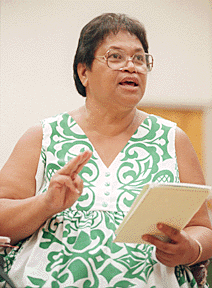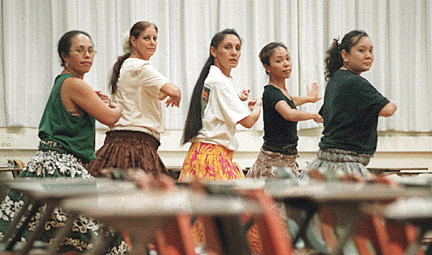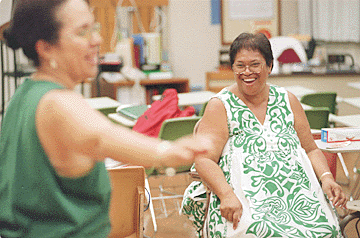


The dance is the part you see,
but at the core is the soul of a
culture for kumu hula HeineJudging: It's a tough job
By Cynthia Oi
Star-BulletinTHE front door of the tidy white house on a cul-de-sac in Waimanalo swings with the comings and goings of children.
"Hi, auntie," Morgan says, elongating the vowels in the desultory way of a bored youngster.
"Hello, Morgan," replies Leina'ala Kalama Heine in the same manner, as the neighbor boy kicks off his slippers and shoulders past the screen door into the living room where five other kids watch "How Stella Got Her Groove Back" on TV.
The children are hers, Heine says, her nieces, nephews, grand-nephews, grand-nieces and kids from her neighborhood. She claims the young with the same nurturing spirit with which she claims hula.

She is one of seven judges for the Merrie Monarch Festival hula competition this week. The seven are all kumu hula, teachers of the hula. But it is not the status of kumu hula that qualifies them, Heine says. What does is that they are "practitioners.""We do it. We are practitioners. It is what we do and the responsibilities we have as practitioners."
The "it" she's talking about is hula. Much more than a dance, it is an embodiment of being Hawaiian and of being part of the land, she says.
Hula tells the stories of Hawaii through movement, language and chants, and natural adornments and instruments. All are tied to the land from which the people and the legends evolved.
No matter how many times she drives along the coast from town to Waimanalo, the views still move her soul, she says.
"You come around that peak at Makapuu and you see the sweep of the ocean from the land -- it takes my breath away. It's never the same.
"But the earth, the roots that we have here is the same because that's what we have. It's not ownership, possession. We're talking about being part of this land," she says.
"It doesn't only belong to us today. It belongs to the ancestors that came before us." So when the Hawaiian community defends its right to fish the oceans and to gather from the land, "we're battling for the ancestors of the land we came from."

As a member of 'Ilio'ulaokalani, the coalition of kumu hula and halau focusing on Hawaiian rights, the pure Hawaiian woman tracks bills in the legislature that may have an effect on her community.She rails against lawmakers who don't know who their constituents are and what they want.
"They sit in their offices up there and they don't know what our needs are. They don't know who we are. That's why we have to go down there and and tell them."
She also admonishes all citizens to take part in the political process.
"People vote for this guy or that one. But do you really know who your council members and your legislators are? Do you tell them what you want? If you don't ..." she leaves the sentence unfinished and flicks her hand as if batting away a pesky fly.
Heine believes the government -- by passing laws she sees as cutting off Hawaiian cultural and traditional practices, by failing to turn over money for ceded lands, by ignoring Hawaiian affairs -- is pushing that community toward sovereignty.
"It's getting to the point where we say get them out of there; we don't need the governor, we don't need the house of representatives, we don't need the senators.
"We're not talking about a nation within a nation. That's saying to them we're satisfied with you, we can work with you.
"I'm talking about a complete, sovereign nation. If we make mistakes, we make mistakes. That's ours."
There was a time, she says, when Hawaiians "were ashamed to say they were Hawaiian." The stereotype of a lazy, unproductive race kept many away from their culture. That's because of a Western viewpoint. "You had to be industrious, working, making money, be 'educated.'
"Walking away from our heritage was momentous. Our parents thought that this was the way to help us survive," says Heine.

"The haole perception of success isn't bad, but that was for haoles."It's only now we understand that we don't have to be that way to be successful. We have become educated, yes, but have maintained our heritage."
That education has helped Hawaiians in dealing with the Western political structure, she says.
"So now we have the background of our ancestors and the education. Now we can identify, we don't have to split our personality, we can now become both. That makes us the practitioners.
"You cannot fool us anymore."
This is a woman who has raised four of her own children as well as the nieces, nephews and other relations, who teaches at St. Andrew's Priory, who performs with the Brothers Cazimero, and who for 23 and a half years has taught students in her halau for free.
"I'm training ladies to become teachers. I'm teaching them to be the practitioners," she says. Although there is an increasing number of language and cultural teachers, she believes there is a need for more. "We don't have enough teachers, not enough to go around."
At 58 years old, Heine's "dance-itis" forces her to take tender steps when she walks the paths around her house. As a steward of the land, Heine has graced her yard with the flowers and plants she needs in presenting hula.
"I decided when I got this place, I was going to put all those things that I need for the halau in my yard so that I can replenish." She sweeps her eyes over the Koolau ridge behind her house. "Because those mountains are being wiped out."
Ginger, puakenikeni, pikake, ulu, gardenia and endangered hibiscus surround the lawn. In a big bucket next to the front door are two different kinds of ti, ready for planting in her garden.
Also thriving are kalo and a small but healthy ohi'a tree.
"People told me those would never grow, but look," she says, obviously pleased. "When people say cannot do this ..." she leaves off the sentence and again flips her hand.
Judging: It’s a tough job
By Cynthia Oi
Star-BulletinKumu hula Leina'ala Kalama Heine will be a judge for the fourth time in the Merrie Monarch Festival hula competition.
Heine, who has taught hula for more than 23 years, explained the criteria by which winners are chosen.
Ten is the highest number of points that can be awarded for each element, except for interpretation, when the highest number of points is 15.
A halau may score as many as 125 points in the 'auana (modern) and kahiko (ancient) divisions. Miss Aloha Hula competitors may score as many as 125 in the kahiko division where the judging criteria include an oli (chant). In the 'auana division, there is no oli and the maximum number of points is 115.
The criteria
Ka'i, the entrance. This, along with the ho'i, or exit, have protocol or ceremonial bases.
Interpretation. This, Heine says, is the second most important aspect of the hula. The mele or chant is likely to be familiar to all the judges and a fact sheet, which each halau prepares before the competition, helps the judges decide on the validity of the interpretation presented.
Research a haumana (student) conducts to complete the fact sheet is a large part of the learning experience, Heine says. If the mele or chant involves a site or historic location, a visit to the place enhances the haumana's performance, she says, because "when you know, when you were there, you can express."
Expression. This element requires the proper demeanor of the dancers for the song or chant presented.
Posture. Different halau have different techniques, Heine says. Some may dance in a lower position while others may dance straight up. "It depends on where the dance is coming from, on the interpretation," she says.
Precision. "If one dancer falters," Heine says, "that's because of nervousness, pressure. That's excusable. But if there are continuous mistakes through the whole dance, then you take away points. That's carelessness."
Hand gesture. This element is closely tied to interpretation and expression. It must also be precise.
Foot or body movement. If the dancers are seated, the criterion relates to the body; if standing, the judgment is placed on the feet.
Heine says foot movement is the most important element in hula. The foot movement is defined by the beat of the drums or the ipu heke (double gourd drum); the beat and foot work must match. There are basic foot patterns, she says, and "anything out of that isn't hula.
H'oi, the exit. (See Ka'i)
Authenticity. The clothing or costumes must tie into the song or chant and the time period in which it is situated.
Adornments. These must be researched and must be tropical.
Grooming. The personal appearance of each dancer must fit in with the rest of the costume and adornments. For example, no makeup should be worn for the kahiko performance, Heine said.
Overall performance. Points given for this element takes into account the total impression of the dance and cohesiveness of the performance.
Merrie Monarch judges
Judges for the 36th annual Merrie Monarch Festival hula competition are:
Cy M. Bridges: kumu hula; musician; composer; genealogist, Polynesian Cultural Center Cultural Islands Director
Ed Collier: kumu hula, Halau Hula O Na Pua Kukui, overall winners of the 1998 World Invitational Hula Festival; Iolani School dance teacher
Donna Leialoha Amina: kumu hula, Na Lei 'O Kaholoku
Pualani Kanaka'ole Kanahele: kumu hula, Halau O Kekuhi; assistant professor of Hawaiian studies and language, Hawai'i Community College
Victoria Holt Takamine: kumu hula, Pua Ali'i 'Ilima; instructor of Hawaiian music, dance and culture, University of Hawaii at Manoa, Leeward Community College and University High School
Noenoelani Zuttermeister Lewis: kumu hula; lecturer of Hawaiian chant and dance, University of Hawaii at Manoa
Leina'ala Kalama Heine: kumu hula, Na Pualei O Likolehua; teacher, St. Andrew's Priory; performer with the Brothers Cazimero
Click for online
calendars and events.